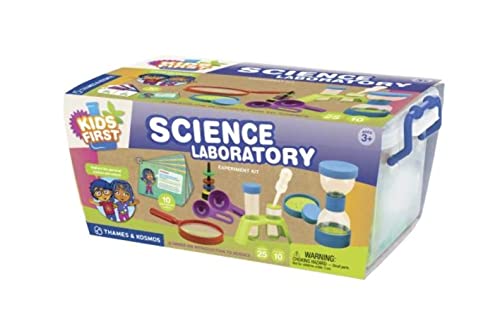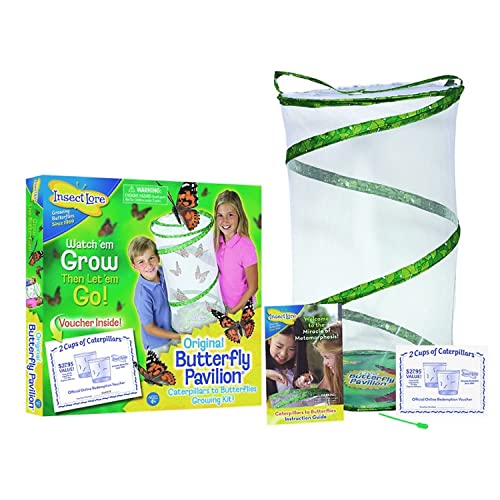Science kits for 5-year-olds are designed to give kids a hands-on opportunity to learn about science. Kits typically include experiment materials and detailed instructions. They can be used to teach kids about a variety of topics, including physics, chemistry, and biology.
There are a variety of science kits available on the market, so it is important to choose one that is appropriate for your child’s age and interests. If your child is interested in nature, you may want to consider a science kit that includes a microscope. If your child is interested in dinosaurs, you may want to consider a science kit that includes a dinosaur model.
We’ll guide you through the selection of the best science kits for your 5-year-old. Additionally, our evaluations of these 10 kits can help you choose quickly and save time, allowing your kid to begin experimenting sooner.
Our Top Picks
- Best Portable Lab: Just Play Ada Twist On-The-Go Lab
- Best Laboratory Kit: Thames & Kosmos Kids First Science Laboratory Kit
- Best For Butterfly Lovers: Insect Lore Butterfly Pavilion
- Best For Insect Observation: Fat Brain Toys Buggy Light
- Best For Dinosaur Lovers: Creativity for Kids Create with Clay Dinosaurs
- Best Robot Kit: KinderLab Robotics KIBO 15 Home Edition
- Best Kit For Nature Lovers: The Magic School Bus Rides Again
- Best For Junior Scientists: Little Tikes STEM Jr. Wonder Lab Toy
- Best With Microscope: Educational Insights GeoSafari Jr. Explorer Scope
- Best For Beginners: Scientific Explorer My First Science Kids Science Experiment Kit
In This Article
HappyBabyHub’s Best Science Kits For 5-Year-Olds Picks
1. Just Play Ada Twist On-The-Go Lab – Best Portable Lab
- Very easy experiments
- Sturdy accessories
- Cute design
- Makes for a great gift
- May require adult supervision
This fascinating portable lab unfolds to reveal everything your little scientist needs for a hands-on, mind-blowing exploration. Inspired by the popular Netflix series Ada Twist, Scientist, this lab set is sure to inspire and spark imagination.
With this role-playing kit, kids can perform their very own experiments and learn all about the scientific method. Equipped with goggles and a set of cards, they can determine which tools and basic materials are required from home, giving them an authentic scientific experience. The set encourages children to ask all the right questions: Who, What, Where, When, How, and Why?
2. Thames & Kosmos Kids First Science Laboratory Kit – Best Laboratory Kit
- Great for young scientists
- Entertaining
- A great way to encourage and foster a love of learning and exploring science
- Nicely oversized to accommodate smaller hands that are working on dexterity
- Science Behind It explanations are a bit lacking
As parents, we all want our children to grow and learn by exploring the world around them. The latest educational philosophy encourages kids to follow their interests and curiosity, and this science kit is designed to do just that for 5-year-olds.
The kit includes 24 sturdy plastic instruments that are safe and fun for your child to experiment with. They can mix, pour, and measure using the 14-piece screw-together system, which includes interchangeable tubes, funnels, lids, connections, and perforated disks. There are also measuring spoons, a test tube rack, a pipette, a hand magnifier, a pair of magnetic rings and stands, and ten experiment cards with illustrations to keep your child’s curiosity going for hours!
3. Insect Lore Butterfly Pavilion – Best For Butterfly Lovers
- The cage itself is reusable, and there are directions about how to obtain new batches of caterpillars in the future
- Fun to watch the butterfly process
- The pavilion size is great as it really allows more to fit
- Great for nature lovers
- You have to order the caterpillars after you receive the habitat
This Butterfly Pavilion Habitat, a 2-foot-tall, reusable cylindrical mesh container, is the perfect tool for observing the butterflies up close. Hang it from the Velcro strap or place it on a desk or table for a closer look. And when you’re done, it’s a breeze to store.
The full metamorphosis from caterpillar to butterfly takes approximately three weeks, depending on temperature and humidity. After the caterpillars have transformed into chrysalids, carefully move them to the pop-up butterfly habitat. Then, in just seven to ten days, watch with amazement as the butterflies emerge from their chrysalids and take flight.
4. Fat Brain Toys Buggy Light – Best For Insect Observation
- Ideal for bug lovers
- Affordable
- Fosters observation
- Great for 5-year-olds
- Not the best material but it works
Are you tired of your kids catching bugs and keeping them in jars with punched holes? Introducing the insect explorer light, an innovative way to enhance your child’s outdoor experience while keeping insects safe and contained.
Featuring built-in oxygen holes and a non-heating light source, this gadget ensures that bugs remain unharmed while your little one examines them under the built-in magnifying lid. Plus, it’s compact and portable, making it an ideal carry-on night light for those spontaneous camping trips or backyard adventures.
5. Creativity for Kids Create with Clay Dinosaurs – Best For Dinosaur Lovers
- Affordable
- Well made
- Guaranteed hours of playtime
- Fun
- Takes a bit to soften the clay
This fun-filled steam experience combines art, adventure, science, and enjoyment, as children learn about prehistoric eras and indulge in prehistoric fantasies by crafting their own T-Rex, Stegosaurus, and Triceratops using colorful clay.
This comprehensive art and craft kit includes everything your child needs to bring these three amazing dinosaurs to life, including plastic dinosaur skeletons, modeling clay tools, wiggly eyes, and non-toxic, kid-friendly art supplies in a range of vibrant colors such as red, blue, green, yellow, and purple.
In addition to crafting, the kit also includes interesting dinosaur facts to help children learn more about these fascinating creatures. With plenty of clay to spare, kids can use their imagination to create more animals or plants to complete a dinosaur-themed landscape.
6. KinderLab Robotics KIBO 15 Home Edition – Best Robot Kit
- Safe to play
- Children can learn a lot
- A lot of experimentation
- Screen-free play
- Expensive
KIBO, the screen-free programmable robot kit, is a fantastic tool for young learners to develop their engineering and coding skills. Kids get to design and decorate their robots and then program them to dance, race, or put on a puppet show. And the best part? KIBO is a long-lasting investment – it’s not a one-time-use toy.
As kids use KIBO, they engage in the engineering design process, which encourages them to ask questions, imagine possibilities, plan and create, test and improve, and share their creations. KIBO’s hands-on approach makes coding and robotics more accessible and enjoyable for your 5-year-old.
7. The Magic School Bus Rides Again – Best Kit For Nature Lovers
- Has everything except baking soda, vinegar, and water
- The book and poster have excellent graphics and concise information
- Very durable
- A lot of fun activities
- The plastic volcano is a bit difficult to deal with
This hands-on STEM kit is a great opportunity for your 5-year-old to become a botanist or zoologist while having fun learning about natural science. With engaging activities and experiments, your child will enjoy casting animal tracks, creating an ant farm, and hunting for treasures in nature!
Your child will have the chance to explore a variety of activities and experiments that will teach them about the fascinating world of nature. From making a bug home to creating paper mache ants, your young scientist will have the opportunity to learn about the life cycle of insects, build ant farms, and even make leaf art. There are also activities to dry flowers, dissolve an eggshell, and so much more!
8. Little Tikes STEM Jr. Wonder Lab Toy – Best For Junior Scientists
- The station is the perfect height for young kids. Everything is accessible; at their little fingertips
- The clip to hold the project instructions is great
- Removable tray
- The circuit connection is a really fun project
- It does not come with measuring cups
Your 5-year-old will love this life-sized lab that comes with 20 exciting STEM projects to keep them entertained for days on end. With just everyday supplies, your little scientists can conduct experiments and watch as the lab comes to life with over 40 silly sounds and phrases!
Make sure to snap in the leg that houses the power switch during installation for a sturdy lab. And with 8 different maze pieces, 3 maze balls, 3 test jars, 3 stirring spoons, a stirring stick, an experiment clip, an eye dropper, and lab goggles included, your kids will have everything they need for their STEM adventures.
9. Educational Insights GeoSafari Jr. Explorer Scope – Best With Microscope
- Big handles and a neck strap that can break away with enough force in case it gets stuck on something
- Would probably stand up to a fair amount of rough play and being dropped
- It’s a great STEM tool as it encourages scientific exploration
- Great concept
- Quite finicky
This amazing microscope will provide your child with hours of learning and excitement! With its comfortable rubber hand grips and detachable neck strap, the microscope is perfect for backyard exploration or nature hikes.
Featuring 8x magnification, this microscope is perfect for observing anything from pebbles and leaves to rolly polies. But what if your child wants to observe something further away? No problem! With the telescopic barrel, you can easily extend the magnification to 15x for a closer look at distant objects.
10. Scientific Explorer My First Science Kids Science Experiment Kit – Best For Beginners
- It is fun and easy to use for little fingers
- The tray is a decent quality of plastic as well
- The test tubes are fairly hard plastic and should last
- There are lots of polyacrylamide crystals
- The plastic cups are cheap and will probably last only a couple of experiments
With this kit, your 5-year-old will learn all about liquid crystals and the science of color. It comes with 8 safe and entertaining activities that allow your child to set up their very own color-mixing lab and experience what it’s like to be a real scientist.
With cross-linked polyacrylamide, three color tablets, three mixing cups, three test tubes, caps, a stand, a pipette, a mixing tray, instructions, and a magnifying glass included, your child will have everything they need to get started on their scientific journey!
How To Choose A Science Kit for 5-Year-Olds?
- Interests: What does your child like to do? What are they interested in? There are science kits available for a wide range of interests, so try to find one that aligns with your child’s interests. For example, If your child is interested in plants, you might want to choose a kit that includes a trip to a botanical garden or a plant nursery.
- Ability: Not all science kits are created equal. Some are more complex than others. Make sure to choose a kit that is appropriate for your child’s ability level.
- Contents: Finding a kit with all the necessary equipment already included makes the process much simpler, thus we advise shopping for such a kit. Even while you can easily undertake scientific projects at home using household goods, it’s best to have everything set up and ready to go for smaller children.
- Ease Of Use: Make sure the instructions are clear and easy to follow. You don’t want your child to get frustrated with the kit.
- Budget: Science kits can vary widely in price from the cheapest one of $20 to the more expensive ones over $200. Set a budget before you start shopping and try to stick to it. In this article, we have all options from budget-friendly to more high-end ones. Just remember to choose a kit that has the right mix of activities and experiments for your child, without breaking the bank.
What Should Be In A Science Kit For 5-Year-Olds?
A scientific kit typically contains beakers, test tubes, safety goggles, and a few safe chemicals. However, not every science kit needs to include all of those components. The components in a scientific kit for physics could be made of cardboard or wood and fit together. What matters is that the product’s box or description makes it clear what is included in the kit and whether additional materials are required to carry out the experiments properly.
How To Make A Science Kit At Home?
Science kits are a great way to get kids interested in science. They can be used to teach basic principles of science or to conduct experiments. You can buy science kits, or make your own at home.
To make a science kit at home, you will need some basic supplies. These include a container, such as a box or a jar; science equipment, such as a magnifying glass, a microscope, or a set of measuring cups; and materials for conducting experiments, such as food coloring, salt, sugar, and baking soda.
You can find instructions for specific science experiments online, or in library books. Once you have gathered all of the necessary supplies, be sure to label each item so that your child knows what it is and how to use it. then, put everything in the container and let your child explore!
Why Are Science Kits Good For Kids?
Science kits are a great way to get kids interested in science, starting in their infant or toddler years (1). They provide a hands-on way for kids to learn about a variety of topics, from chemistry to physics, and ask a lot of questions if they need to (2). Science kits often come with experiments and activities that are fun and engaging, which makes learning about science more enjoyable for kids (3).
Can The Science Kits Be Used Over And Over Again?
Yes, science kits can usually be used multiple times. This is because they generally don’t include consumable items, like chemicals or materials that would be used up in an experiment. However, it’s always a good idea to read the instructions that come with a science kit to make sure that it can be used more than once.











